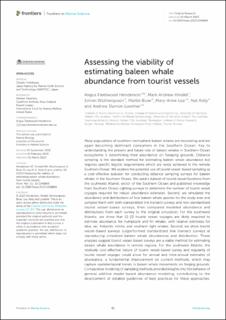| dc.contributor.author | Henderson, Angus Fleetwood | |
| dc.contributor.author | Hindell, Mark Andrew | |
| dc.contributor.author | Wotherspoon, Simon | |
| dc.contributor.author | Biuw, Martin | |
| dc.contributor.author | Lea, Mary-Anne | |
| dc.contributor.author | Kelly, Nat | |
| dc.contributor.author | Lowther, Andrew | |
| dc.date.accessioned | 2023-10-11T13:34:48Z | |
| dc.date.available | 2023-10-11T13:34:48Z | |
| dc.date.created | 2023-03-29T21:45:04Z | |
| dc.date.issued | 2023 | |
| dc.identifier.citation | Frontiers in Marine Science. 2023, 10 . | en_US |
| dc.identifier.issn | 2296-7745 | |
| dc.identifier.uri | https://hdl.handle.net/11250/3095844 | |
| dc.description.abstract | Many populations of southern hemisphere baleen whales are recovering and are again becoming dominant consumers in the Southern Ocean. Key to understanding the present and future role of baleen whales in Southern Ocean ecosystems is determining their abundance on foraging grounds. Distance sampling is the standard method for estimating baleen whale abundance but requires specific logistic requirements which are rarely achieved in the remote Southern Ocean. We explore the potential use of tourist vessel-based sampling as a cost-effective solution for conducting distance sampling surveys for baleen whales in the Southern Ocean. We used a dataset of tourist vessel locations from the southwest Atlantic sector of the Southern Ocean and published knowledge from Southern Ocean sighting surveys to determine the number of tourist vessel voyages required for robust abundance estimates. Second, we simulated the abundance and distributions of four baleen whale species for the study area and sampled them with both standardized line transect surveys and non-standardized tourist vessel-based surveys, then compared modeled abundance and distributions from each survey to the original simulation. For the southwest Atlantic, we show that 12-22 tourist vessel voyages are likely required to estimate abundance for humpback and fin whales, with relative estimates for blue, sei, Antarctic minke, and southern right whales. Second, we show tourist vessel-based surveys outperformed standardized line transect surveys at reproducing simulated baleen whale abundances and distribution. These analyses suggest tourist vessel-based surveys are a viable method for estimating baleen whale abundance in remote regions. For the southwest Atlantic, the relatively cost-effective nature of tourist vessel-based survey and regularity of tourist vessel voyages could allow for annual and intra-annual estimates of abundance, a fundamental improvement on current methods, which may capture spatiotemporal trends in baleen whale movements on forging grounds. Comparative modeling of sampling methods provided insights into the behavior of general additive model-based abundance modeling, contributing to the development of detailed guidelines of best practices for these approaches. Through successful engagement with tourist company partners, this method has the potential to characterize abundance across a variety of marine species and spaces globally, and deliver high-quality scientific outcomes relevant to management organizations. | en_US |
| dc.language.iso | eng | en_US |
| dc.title | Assessing the viability of estimating baleen whale abundance from tourist vessels | en_US |
| dc.title.alternative | Assessing the viability of estimating baleen whale abundance from tourist vessels | en_US |
| dc.type | Peer reviewed | en_US |
| dc.type | Journal article | en_US |
| dc.description.version | publishedVersion | en_US |
| dc.source.pagenumber | 14 | en_US |
| dc.source.volume | 10 | en_US |
| dc.source.journal | Frontiers in Marine Science | en_US |
| dc.identifier.doi | 10.3389/fmars.2023.1048869 | |
| dc.identifier.cristin | 2138309 | |
| cristin.ispublished | true | |
| cristin.fulltext | original | |
| cristin.qualitycode | 1 | |
